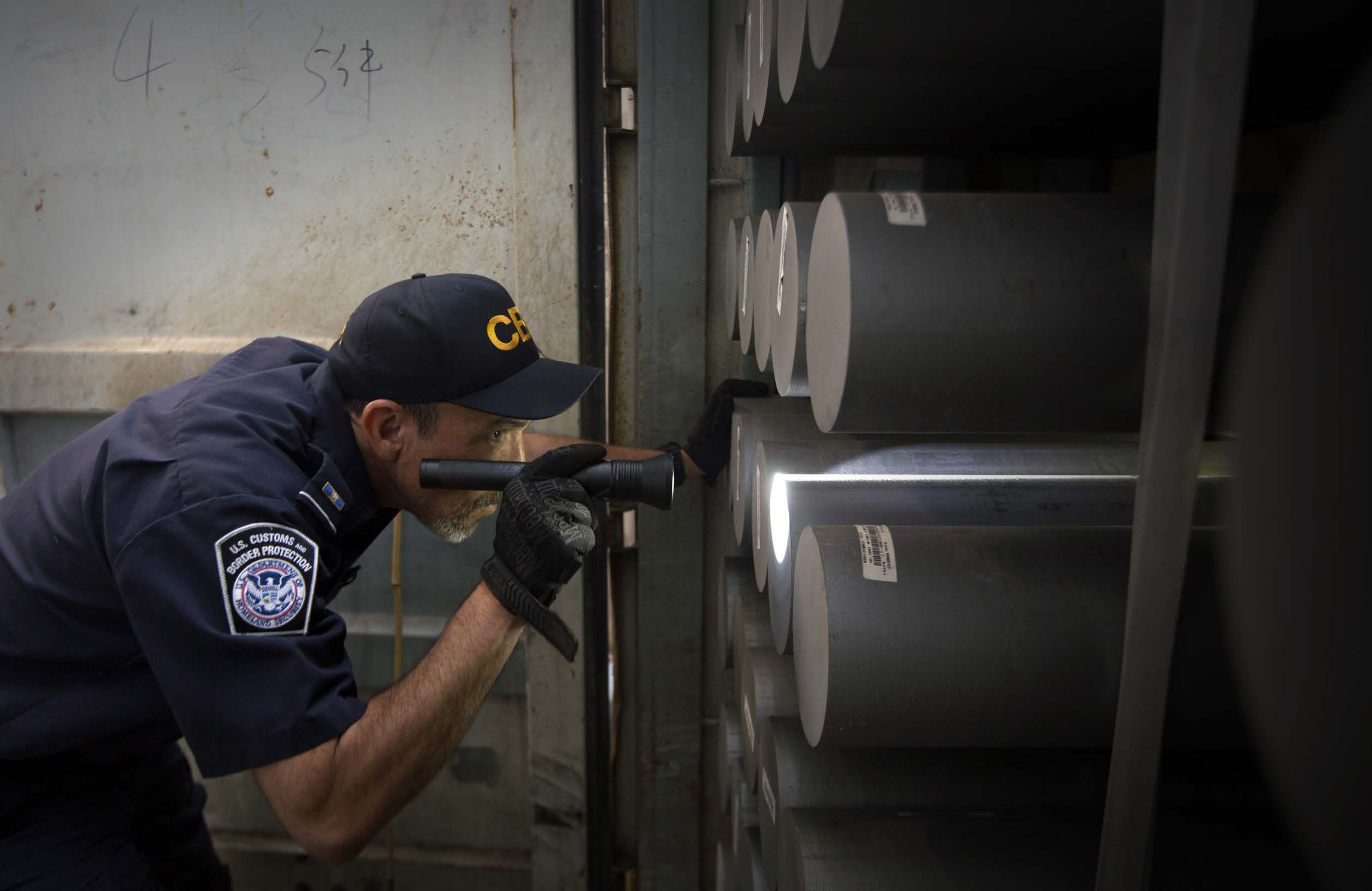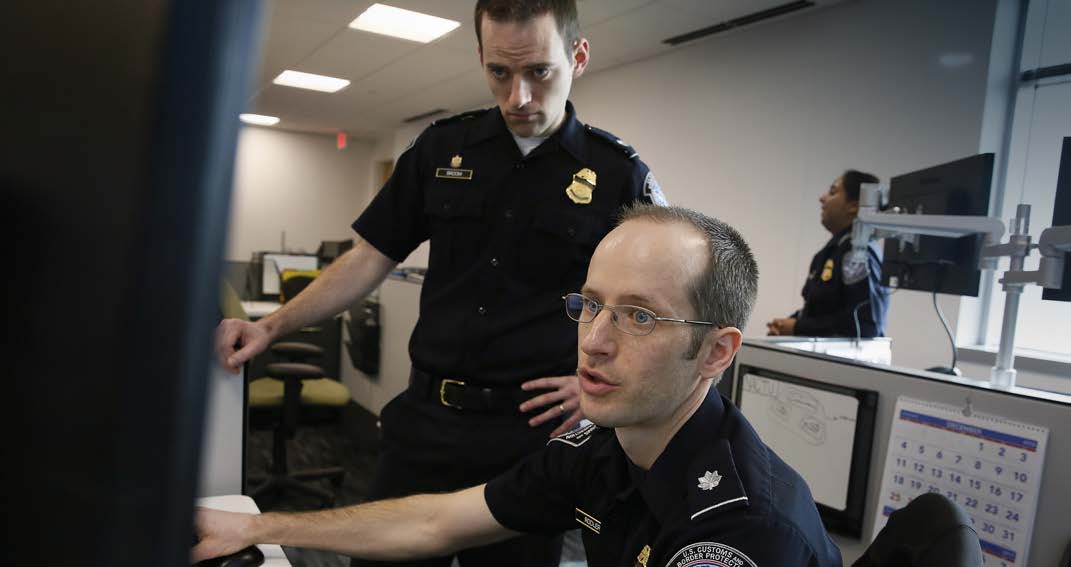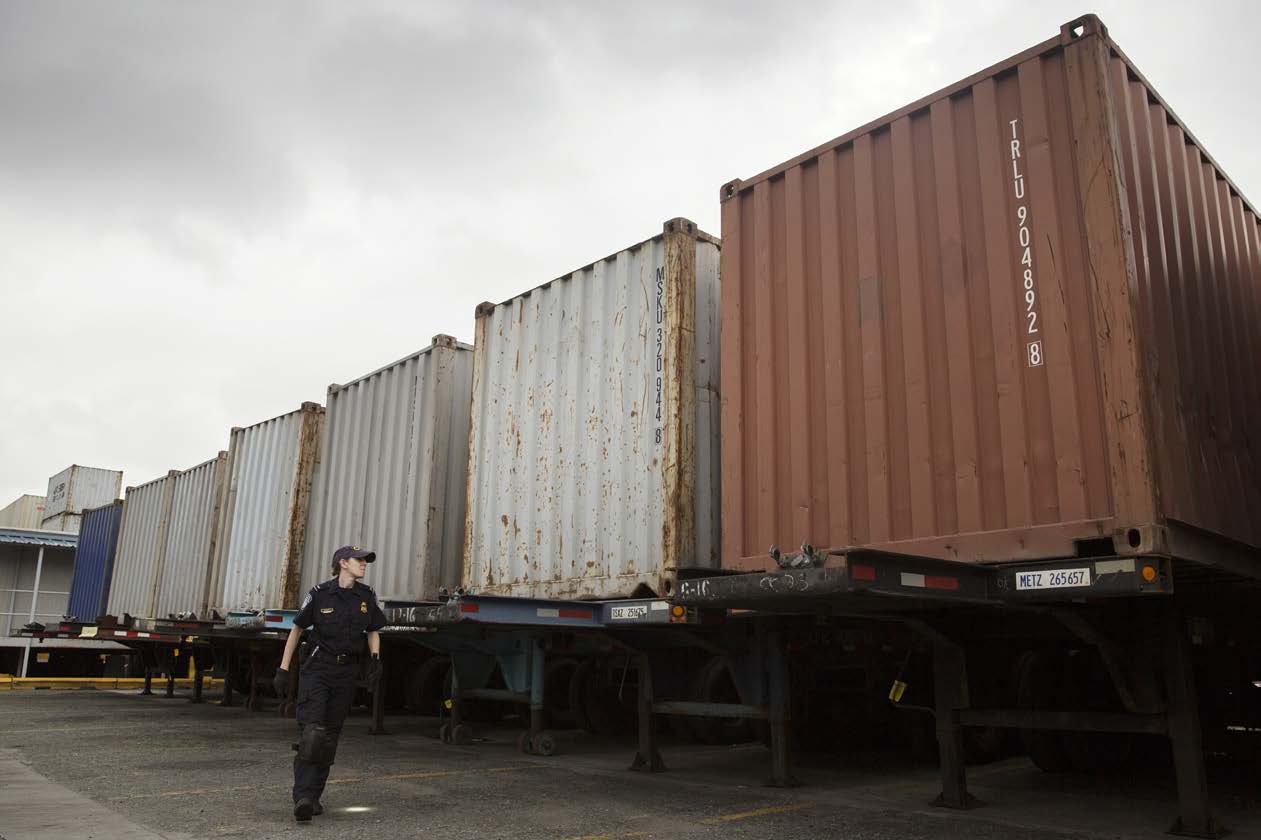


An intercepted seed of a tridax daisy, or coatbutton (Tridax procumbens), found on a maritime shipment of metal products at the Port of Baltimore. The plant is a federal noxious weed and has pest status in nine states. Photo by Glenn Fawcett
Alix Garnier crawls out from under a steel shipping container of aluminum coils at the Baltimore seaport, gingerly holding a glass vial between his thumb and forefinger. The agriculture specialist for U.S. Customs and Border Protection squints at the tiny object inside.
Nearby, Garnier’s colleague, CBP Agriculture Specialist (CBPAS) Timothy Morris, has found mollusks on the exterior of the same cargo container. One of the snails was identified as an Amber Snail (Succineidae, sp.)—and that’s enough to warrant sending the container back to South Africa.
A few miles inland, at the CBP Centralized Examination Station, CBPAS John Taylor is lying on the ground with a flashlight, peering underneath and through the slats of rough wooden pallets that hold stacks of terra cotta flower pots. At this moment, he’s more worried about seeds than splinters.
One of CBP’s many important responsibilities is to prevent potentially harmful or dangerous plant and animal material from entering the U.S. This includes insect pests, invasive plants, plant pathogens, and prohibited animal products that could be carrying diseases that could hurt U.S. livestock or humans.
In fiscal year 2016, CBP agriculture specialists conducted more than 9,800 cargo inspections at the Baltimore seaport.
The primary commodities that come through the port are salt, automobiles, sugar, gypsum, plywood, paper, iron ore, oil, and aluminum. Most of these commodities seem like they would be fairly low-risk for agriculture violations—compared to the tons of cut flowers that arrive in Miami, for example.
But Garnier and Taylor know all too well that some dangers are lurking in—and on—the containers themselves, or in the ubiquitous wooden shipping pallets. In fact, of CBP’s 328 international ports of entry, the Port of Baltimore ranks number one in general cargo “reportable” pests – those that are reported to the U.S. Department of Agriculture.
Meanwhile, 55 miles southwest of where Garnier, Morris, and Taylor are working, in a highly secure state-of-the-art office building in Northern Virginia, five specially trained agriculture specialists are scanning screens to see what sorts of agriculture cargo are on its way to our nation’s 328 land, air, and sea ports of entry. They occupy just a tiny corner of a vast open sea of hundreds of desks staffed by experts on counterterrorism, immigration admissibility, and other specialized disciplines aimed at securing the U.S. border.
Welcome to the National Agriculture Cargo Targeting Unit, or NACTU. These analysts provide key intelligence to frontline agriculture specialists like Garnier and Taylor, letting them know if a shipment warrants further scrutiny.
The NACTU researches cargo shipments being imported to the U.S. and analyzes national agriculture quarantine activity to identify shipments that pose a significant risk to U.S. agriculture and natural resources. These potential threats include animal pathogens that could harm livestock and people; invasive plants that could damage our ecosystems; and insect pests and plant diseases that could hurt crops and forests.

Agriculture specialists of the National Agriculture Cargo Targeting Unit monitor inbound shipments and traveler-imported agricultural products as they work at the National Targeting Center in the National Capital Region. Photo by Glenn Fawcett
Identifying the need
The idea for creating a targeting unit specifically on agriculture cargo originated nearly a decade ago, but efforts got under way in earnest in 2014 when the CBP Office of Field Operations’ Agriculture Programs and Trade Liaison office contacted CBP’s National Targeting Center, or NTC, to explore options for piloting the unit and collocating it at the cargo portion of the NTC’s facility outside Washington, D.C.
“We assembled a working group of subject matter experts from various field offices and worked closely with NTC advisers to develop plans to pilot a unit,” recalled Supervisory CBP Agriculture Specialist Nikki Thomas, one of the founders of the NACTU. CBP conducted six pilot cycles before establishing the NACTU as a permanent, full-time unit in September 2015 as part of the Agriculture Safeguarding Unit.
The five permanent NACTU targeters are led by Branch Chief Nidhi Singla, and they receive assistance from interns who rotate in from the field, bringing valuable knowledge and expertise with them about trends they see developing at the ports of entry.
“The goal is to cross-pollinate knowledge we have residing in the field with that of our permanent targeters here in NACTU, and then to send them back to the ports with the knowledge they receive here,” said Singla.
The targeters have varied backgrounds and experience. For example, after earning a bachelor’s degree in biology, Agriculture Operations Manager Samuel Broom interned with U.S. Fish and Wildlife Service in New Hampshire, researching the spawning habits of Atlantic salmon, and then tracking desert tortoises in the Mojave Desert for the U.S. Geological Survey.
“We focus not just on agriculture materials themselves—fruits and vegetables and animal products that could harbor pests and diseases—we also look at the miscellaneous commodities that are also capable of harboring pests and pathogens, such as wood packaging materials like pallets, as well as tiles and even steel,” said Singla.
Shipments are sent from the Baltimore seaport to the examination station if CBP believes they merit further inspection. At the station warehouse, agriculture specialists are inspecting a shipment of nails from China—packed on wooden pallets. The reason for the referral: targeters had information indicating the shipment may be contaminated with a weed seed of Imperata cylindrica, or cogongrass, which is classified as a federal noxious weed, or FNW.
Many types of weed seeds—like those of cogongrass—have feather-like protuberances that serve as “wings” when the wind blows, carrying them to other areas—often sticking to the rough wood of shipping pallets. The production of seeds is seasonal, so certain times of year are worse than others in terms of interceptions, depending on the country of origin.

A CBP agriculture specialist at the Port of Baltimore looks at cargo container exteriors. Photo by Glenn Fawcett
Finding the target
The targeters who work for the NACTU need the tenacity of private investigators and the patience of stakeout cops. They must be detail oriented and willing to trace the path of a shipment—not just the physical trajectory of the actual cargo, but the paper trail itself.
For example, a shipment from a certain country might list a major city as the cargo’s origin because that is the manufacturer’s headquarters location. But the materials may have actually been grown, processed, or packed in a remote part of the country where noxious weeds such as wild sugarcane (Saccharum spontaneum) grows. Wild sugarcane is an important habitat for certain animal species, and it is often harvested to thatch roofs.
But here in the U.S., wild sugarcane can quickly colonize disturbed soil to take over fields and pastures, choking out native grasses and crops. In fact, wild sugarcane is on the FNW list, along with cogongrass and more well-known nuisances like mile-a-minute vine (Mikania micrantha Kunth) and kudzu (Puerara montana). Deliberate importation of it is prohibited without a permit from the USDA’s Animal and Plant Health Inspection Service.
The NACTU targeters know this. So based on the trends they see—and patterns of deception—they will flag such shipments for the kind of inspection that requires flashlights and magnifying glasses—so not even one weed seed crosses the border.
Today, the NACTU provides targeting support to all CBP environments—air, sea, and land ports of entry—including rail and truck crossings and international mail and express consignment facilities. Its weapon of choice: CBP’s Automated Targeting System, or ATS.
ATS is a Department of Homeland Security computer system that applies “risk assessment” principles for comparing traveler, cargo, and conveyance information against law enforcement intelligence and other enforcement data. Based on ATS data, CBP identifies people and cargo that may require additional scrutiny, while facilitating the entry of low-risk commodities.
Focused squarely on agriculture, the NACTU does not perform targeting activities for other trade issues, such as potential violations of intellectual property rights or antidumping and countervailing duty evasion. But the NACTU does collaborate regularly with other targeting organizations by referring intelligence to relevant targeting units, such as CBP’s 10 industry-specific Centers of Excellence and Expertise or the Commercial Targeting and Analysis Center.
Taking aim
Besides conducting national agriculture quarantine targeting, the NACTU provides field support and targeting oversight for cargo pathways nationwide. The NACTU has assumed a field support role and is available via direct field support line seven days a week to provide guidance, and assist with research requests to analyze field intelligence.
NACTU also functions as a clearinghouse of sorts, facilitating the communication of observed risk across all port locations. The quarantine activities at the Port of Baltimore, for example, have influenced exams in other port locations.
Here is how it works: the high numbers of FNW interceptions on metal commodities and containers in Baltimore—like those found by Garnier, Morris, and Taylor—are reviewed by the NACTU’s analysts at the NTC. Certain data about these shipments are applied to a national “user defined rule.” The rule is used to identify shipments that might require extra scrutiny by agriculture specialists in other locations.
Collocation at the NTC makes it easier to share information, and the NACTU collaborates regularly with CBP’s other targeting personnel by referring intelligence to the relevant targeting units and centers. “Increasing collaboration with partner government agencies and industry stakeholders really enhances CBP’s ability to execute its agriculture mission,” said Singla.
Each pathway—air, land, sea, and international express consignment—poses its own challenges, Singla explained. Land border commercial cargo is especially difficult. While manifests for cargo ships or planes are available a day or two—or even weeks—before the cargo arrives, manifests for shipments arriving by truck or rail are often available for analysis only a few hours before the goods get here.
Then there are the challenges posed by “intermodal” pathways. Say a shipment destined for San Diego arrives in Mexico’s Manzanillo seaport on the Pacific Ocean from Hong Kong. It might then be offloaded and placed on a train and sent northbound to Tijuana, where it might be offloaded again and divided onto trucks before crossing the border to San Diego. The NACTU targeters need to make sure that the manifests for this shipment remain consistent.
Significantly, the NACTU does not replace the local port’s targeting operations. Instead, the unit helps to focus CBP on critical and higher-risk agriculture quarantine inspections, providing extra capacity for agriculture quarantine targeting. “The NACTU is a force multiplier. It augments the targeting efforts that are already in place at the ports,” according to Singla.